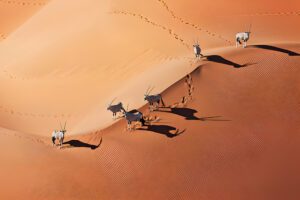Deserts are dry, barren, and often hostile environments that cover about one-third of the Earth’s land surface.
Despite the harsh conditions, many animals have adapted to live in the desert and thrive in their own ways. In this blog post, we will explore the types of animals that live in the desert, their adaptations, and their roles in the ecosystem.
Types of Animals That Live in The Desert
Animals that live in the desert can be classified into different categories based on their behavior, diet, and habitat. Some of the common categories are:
Nocturnal animals: These are animals that are active at night and sleep during the day. They avoid the scorching heat of the sun and use the cooler temperatures to hunt, feed, and mate. Some examples of nocturnal desert animals are owls, bats, rodents, and some insects.
Diurnal animals: These are animals that are active during the day and sleep at night. They have to cope with the high temperatures and exposure to the sun. Some examples of diurnal desert animals are lizards, birds, antelopes, and some reptiles.
Herbivorous animals: These are animals that feed on plants, seeds, fruits, and other vegetation. They have to find sources of water and nutrients in the sparse and dry desert flora. Some examples of herbivorous desert animals are camels, rabbits, gazelles, and some rodents.
Carnivorous animals: These are animals that feed on other animals, either by hunting, scavenging, or parasitizing. They have to compete with other predators and prey on the limited and elusive desert fauna. Some examples of carnivorous desert animals are foxes, snakes, scorpions, and some spiders.
Omnivorous animals: These are animals that feed on both plants and animals, depending on the availability and preference. They have a more varied and flexible diet than herbivores or carnivores. Some examples of omnivorous desert animals are coyotes, skunks, badgers, and some birds.
Burrowing animals: These are animals that dig holes, tunnels, or chambers in the ground. They use their burrows to escape the heat, cold, predators, or competitors. They also store food, water, or offspring in their burrows. Some examples of burrowing desert animals are meerkats, ground squirrels, gerbils, and some insects.
Animals That Live In The Desert
Animals that live in the desert have evolved to cope with the harsh conditions of the desert. They have developed various adaptations, such as:
Physiological adaptations: These are changes in the body functions or processes of the animals. They help the animals regulate their body temperature, water balance, metabolism, or reproduction. Some examples of physiological adaptations are:
Camels can store fat in their humps and water in their blood cells. They can also tolerate dehydration and high body temperature.
Kangaroo rats can survive without drinking water. They get their water from the seeds they eat and from their urine. They also have efficient kidneys that produce very concentrated urine.
Scorpions can slow down their metabolism and enter a state of dormancy. They can survive for months without food or water.
Morphological adaptations: These are changes in the body structures or features of the animals. They help the animals protect themselves, move, or sense their surroundings. Some examples of morphological adaptations are:
Fennec foxes have large ears that help them dissipate heat and hear their prey. They also have thick fur that insulates them from the cold and sand.
Horned lizards have spiny scales that deter predators and camouflage them. They also have the ability to squirt blood from their eyes as a defense mechanism.
Cacti wrens have curved beaks that help them extract seeds from cacti. They also have long legs and claws that help them climb and perch on cacti.
Behavioral adaptations: These are changes in the actions or habits of the animals. They help the animals communicate, cooperate, or cope with their environment. Some examples of behavioral adaptations are:
Meerkats live in groups called mobs. They have a complex social structure and communication system. They also take turns to guard, forage, and babysit.
Roadrunners run at speeds of up to 32 km/h. They use their speed to catch their prey and escape their predators. They also sunbathe to warm up their body temperature.
Ostriches bury their eggs in the sand. They use the sand to incubate their eggs and hide them from predators. They also use their feet to kick their enemies.
Roles of desert animals in the ecosystem
Animals that live in the desert interact with each other and with their environment. They play important roles in the biodiversity, stability, and functioning of the desert ecosystem. Some of the roles are:
Food chains: These are the relationships between the producers, consumers, and decomposers in the ecosystem. They show how energy and matter flow through the ecosystem. Some examples of food chains in the desert are:
Cactus -> cactus wren -> snake -> hawk
Grass -> antelope -> lion -> vulture
Flower -> bee -> lizard -> owl
Symbiosis: These are the relationships between different species in the ecosystem. They can be beneficial, neutral, or harmful for the species involved. Some examples of symbiosis in the desert are:
Mutualism: This is a relationship where both species benefit from each other. For example, the acacia tree and the acacia ant. The tree provides shelter and food for the ant, and the ant protects the tree from herbivores and competitors.
Commensalism: This is a relationship where one species benefits and the other is unaffected. For example, the jackrabbit and the coyote. The jackrabbit uses the coyote’s burrow as a refuge, and the coyote does not mind sharing its burrow.
Parasitism: This is a relationship where one species benefits and the other is harmed. For example, the flea and the camel. The flea feeds on the camel’s blood, and the camel suffers from blood loss and irritation.
Competition: This is a relationship where different species or individuals compete for the same resources in the ecosystem. They can reduce the availability or quality of the resources for each other. Some examples of competition in the desert are:
Intraspecific competition: This is competition within the same species. For example, male bighorn sheep compete for females and territory by ramming their horns.
Interspecific competition: This is competition between different species. For example, foxes and coyotes compete for rodents and rabbits as their prey.
Predation: This is a relationship where one species hunts and kills another species for food. They can affect the population size and behavior of the prey and the predator. Some examples of predation in the desert are:
Carnivore predation: This is predation by meat-eating animals. For example, the cheetah and the gazelle. The cheetah uses its speed and stealth to catch the gazelle, and the gazelle uses its agility and endurance to escape the cheetah.
Herbivore predation: This is predation by plant-eating animals. For example, the locust and the grass. The locust consumes large amounts of grass, and the grass suffers from defoliation and nutrient loss.
See also: Fish with big eyes
Conclusion
Animals that live in the desert are diverse, adaptive, and important for the desert ecosystem. They have different types, adaptations, and roles that help them survive and thrive in the desert. They also face many challenges and threats from the environment and from each other.
We can learn a lot from these animals and their amazing abilities. We can also help protect and conserve them and their habitats by raising awareness, supporting conservation efforts, and reducing our environmental impact. As the famous naturalist John Muir once said, “When we try to pick out anything by itself, we find it hitched to everything else in the universe.”

